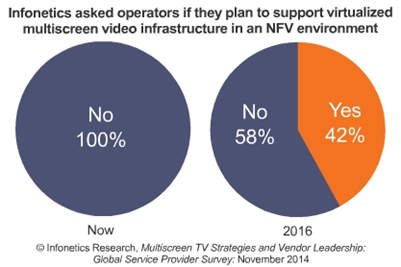 アナリストノート
「サービスプロバイダーは、エンコードしてビデオコンテンツを配信するのに慣れていたプラットフォーム処理に柔軟性を求めています。ネットワーク機能バーチャライゼーション(NFV)は、エンコーダーやビデオ・オン・デマンド(VoD)配信サービスのようなネットワークハードウェアに通常内蔵されている機能を、標準サーバ上のバーチャルなマシーンで動作するソフトウェアに移行させます。これによりオペレーターはビデオコンテンツの処理と配信に際して、さらなる柔軟性を獲得します」と、Infonetics Researchでブロードバンドアクセスとペイテレビを担当している主席アナリストのJeff Heynen氏は述べている。
アナリストノート
「サービスプロバイダーは、エンコードしてビデオコンテンツを配信するのに慣れていたプラットフォーム処理に柔軟性を求めています。ネットワーク機能バーチャライゼーション(NFV)は、エンコーダーやビデオ・オン・デマンド(VoD)配信サービスのようなネットワークハードウェアに通常内蔵されている機能を、標準サーバ上のバーチャルなマシーンで動作するソフトウェアに移行させます。これによりオペレーターはビデオコンテンツの処理と配信に際して、さらなる柔軟性を獲得します」と、Infonetics Researchでブロードバンドアクセスとペイテレビを担当している主席アナリストのJeff Heynen氏は述べている。「最新のマルチスクリーン調査のために当社がインタビューしたサービスプロバイダーについては、NFV環境のもとでバーチャライズされたマルチスクリーンビデオインフラをサポートしている企業はありませんでしたが、2016年までに(その割合は)42%まで高まるでしょう」と、Heynen氏は続けて述べている。 マルチスクリーンテレビ調査のハイライト
- 回答のあったサービスプロバイダーの58%は現在、一般家庭における3つの主要マルチスクリーン機器(タブレット端末、デスクトップパソコン・ノートパソコン、携帯電話)をサポートしている。
- 調査対象オペレーターの約半数はライブストリーミングを提供している。
- トランスコーディングはますます分散されるようになっている。2015年にビデオコンテンツを自社のヘッドエンドにトランスコードする計画があるのは回答企業の16%にすぎなかった。
- 回答企業は、最も馴染みのあるマルチスクリーンベンダーとしてEricssonとHarmonicを挙げている。
Multiscreen TV providers moving quickly to NFV, shows Infonetics survey Campbell, CALIFORNIA, November 20, 2014-Market research firm Infonetics Research released excerpts from its 2014 Multiscreen TV Strategies and Vendor Leadership: Global Service Provider Survey, which provides insights into pay-TV operators' plans for multiscreen video services and delivering live and file-based video content to subscribers with multiple devices. ANALYST NOTE "Service providers want flexibility in the processing platforms they use to encode and play out video content. Network functions virtualization (NFV) moves functions usually embedded in network hardware-such as encoders and video on demand (VoD) playout servers-into software that can run in a virtual machine on standard servers, giving operators more flexibility in how they process and distribute video content," notes Jeff Heynen, principal analyst for broadband access and pay TV at Infonetics Research.
"Though none of the service providers we interviewed for our latest multiscreen study support virtualized multiscreen video infrastructure in an NFV environment today, this grows to 42% by 2016," adds Heynen MULTISCREEN TV SURVEY HIGHLIGHTS
- 58% of respondent service providers currently support all three primary multiscreen devices in the home: tablets, PCs/laptops, and mobile phones
- Nearly half of operators surveyed offer live streaming today
- Transcoding is becoming more distributed: Only 16% of respondents plan to transcode video content in their headend in 2015
- Respondents rank Ericsson and Harmonic as the most familiar multiscreen vendors

